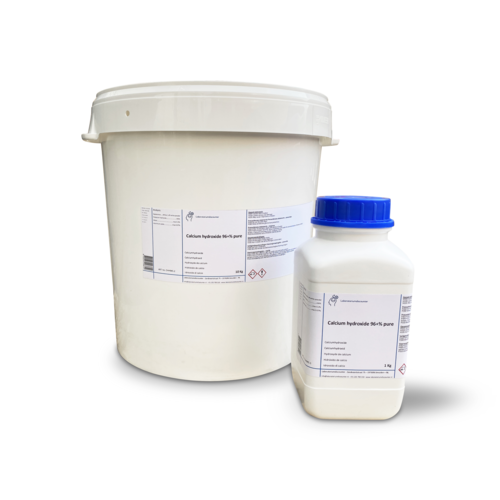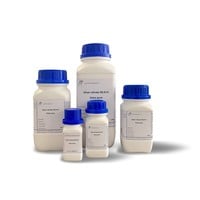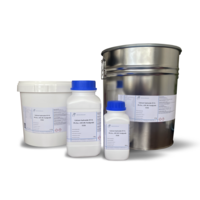You have no items in your shopping cart
Calcium hydroxide 96 +%, slaked lime, pure
- Buy 2 and save 5%
- Buy 10 and save 10%
What is Calcium Hydroxide?
Calcium hydroxide (also: slaked lime, (white) hydrated lime) is the hydroxide of calcium. It is a white solid with chemical formula Ca(OH)2
What is calcium hydroxide used for?
The main use of calcium hydroxide is in the preparation of mortar in construction. It is used there under the name of white calcium hydrate (DIN 1060). Lime plasters consist of mixtures of calcium hydroxide and sand. The latter can also be added in the form of ground limestone. It is also increasingly being added to asphalt mixes to improve the durability of the finished asphalt layer.
Calcium hydroxide is formed when Portland cement hardens. Portland cement is mainly used to manufacture reinforced concrete. The alkaline action of calcium hydroxide in concrete prevents the reinforcing steel from rusting until it is neutralized by carbon dioxide (or other acidic components of rainwater, for example).
Its antiseptic, caustic effect, which inhibits the growth of pathogens and fungi, is why slaked lime was previously used to disinfect stables (the "lime" of stables).
In combination with soda and soft soap, slaked shell lime is processed into Tadelakt, a hydrophobic lime plaster for wet areas.
Lime is used to improve the load-bearing capacity of the construction site. A soil with too high a water content and the resulting low bearing capacity and poor compactability can be improved by mixing 2-4% MA lime. The lime binds part of the water and thus improves the plasticity, compressibility and load-bearing capacity, among other things. Therefore, soil improvement with lime is a method to realize immediately realizable improvement of the laying capacity and to facilitate the execution of construction work.
Slaked lime is used as an alternative to limestone in flue gas desulphurization because it forms calcium sulfate (gypsum) with sulfuric acid. The amount used is about 1.8 times less than for limestone. The resulting plaster has a whiteness of 80% and can be used commercially. Due to the high reactivity, lower consumption quantities are required. The disadvantage is the higher price compared to limestone.
In the food industry, it is added to foodstuffs as an acidity regulator and is generally approved in the EU as a food additive with the designation E 526 without limiting the maximum amount (quantum satis) for food.
It is also used as a medicine in dentistry, especially for disinfecting root canals and cavities and for stimulating new dentin formation.
It is part of the soda lime, which is used in anesthesia machines or rebreathing diving machines to remove carbon dioxide from the exhaled air.
Calcium hydroxide is also used as a pesticide in fruit growing. Here it is used, for example, as a fungicide (agent against fungal infections, such as tree cancer).
Lime water is the (almost) saturated solution of calcium hydroxide and serves as a clear liquid for the detection of carbon dioxide through the formation of calcium carbonate, which precipitates and makes the solution turbid.
Buy Calcium Hydroxide CAS 1305-62-0 ?
Pure quality calcium hydroxide for a friendly price at Laboratoriumdiscounter. Available in different packagings and always with volume discount for multiple packagings. This calcium hydroxide is not food grade! We also sell a Pharma/food grade variant of calcium hydroxide
Technical data
Empirical formula Ca (OH) 2
Molar mass (M) 74.10 g / mol
Density 2.24
Melting point (mp) 550 ° C (dec.)
Solubility: 1.7 g / l (H2O, 20 ° C)
WGK 1
CAS No. [1305-62-0]
EC no. 215-137-3
$$$$$
Hazard statements
H315 Causes skin irritation
H318 Causes serious eye damage
H335 May cause respiratory irritation
Safety recommendations
Precautions - prevention
P260 Do not breathe dust.
P280 Wear protective gloves / eye protection.
Precautions - response
P302 + P352 IF ON SKIN: Wash with plenty of water.
P305 + P351 + P338 IF IN EYES: Rinse cautiously with water for a long period of time
amount of minutes; remove contact lenses, if possible; keep rinsing.
P310 Immediately call a POISON CENTER / doctor.


%%%%%
| MSDS Calciumhydroxide (NL) |
| MSDS Calciumhydroxid (DE) |
| MSDS Calcium hydroxide (EN) |
| MSDS Hydroxyde de calcium (FR) |
| MSDS Hidróxido de calcio (ES) |









